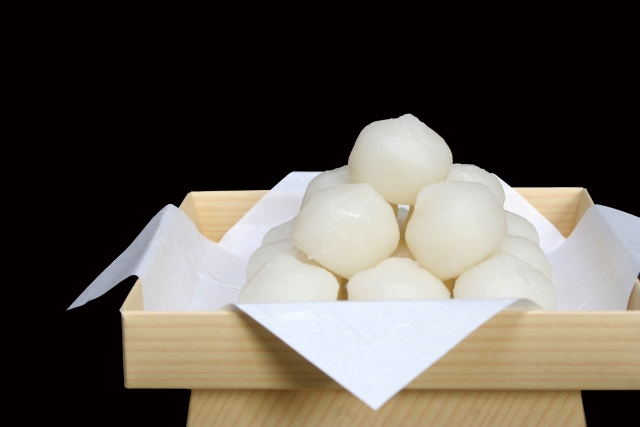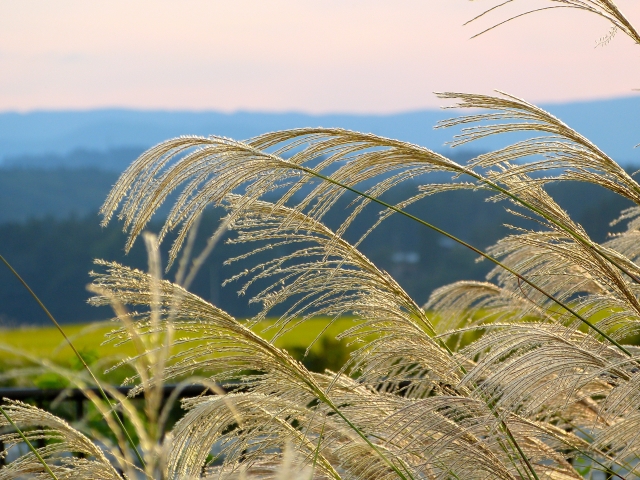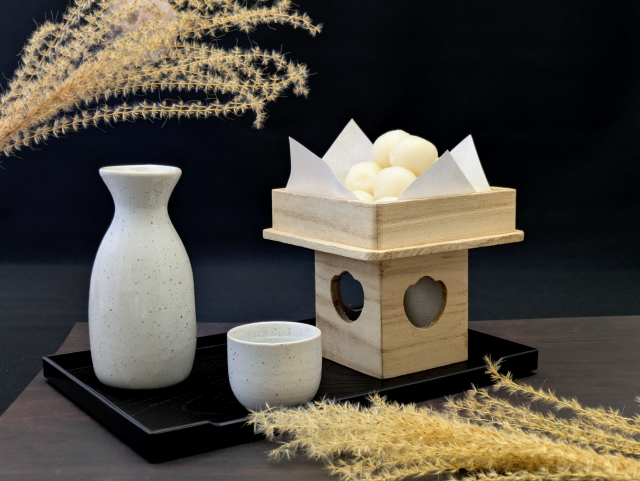The sight of the large, bright full moon has a special traditional and almost romantic meaning in many cultures. In the West, this may be associated mythologically with werewolves, witches and fertility. In Japan, the full moon in the autumn is a special time known as Chushu-no-meigetsu (中秋の名月) or the “Harvest Moon”.
Many people know the Harvest Moon as “Jūgoya (十五夜)”, which literally means “the fifteenth night”. This is a reference to the lunar calendar, where it takes approximately 15 days for the moon to wax from new to full. Consequently, the night of the 15th day after the new moon came to be called Jūgoya.
Jūgoya is not limited to autumn—it technically refers to the 15th night of every lunar month. However, in common usage, “Jūgoya” is associated with the Harvest Moon, specifically the 15th night of the 8th lunar month.
During the Jūgoya festival, people often observe the moon and may see the shape of a rabbit on its surface, a feature highlighted by Japanese mythology.

There is even a song related to Jūgoya:
“うさぎ うさぎ なにみて跳ねる 十五夜お月様観てはねる”
(Usagi, usagi, nani mite haneru, jūgoya otsukisama mite haneru), which translates to:
“Rabbit, rabbit, what are you looking at as you hop? You’re hopping while watching the full moon on the fifteenth night.”
In Japanese culture, the full moon on Jūgoya is often depicted with a rabbit shape. This is not purely imaginary; the craters and markings on the moon’s surface can resemble a rabbit, reinforcing the connection between the myth and the moon’s appearance.
So, when you gaze at the full moon on Jūgoya, you’re not only witnessing a natural phenomenon but also participating in a rich tapestry of cultural stories and traditions that have been passed down through generations.
Origin of the Harvest Moon (Chūshū no Meigetsu)
Today in Japan, the Harvest Moon is often associated with gazing at the moon and eating rice dumplings (dango). However, this custom originally came from China and was introduced to Japan during the Heian period (794–1185).
Chūshū (中秋) refers to the 15th day of the 8th month in the old lunar calendar. Since the lunar calendar considered July–September as autumn, the 15th day of the 8th month marked the middle of autumn. This time of year was also believed to be when the moon was at its most beautiful. Aristocrats in the Heian period held “moon-viewing banquets” (kangetsu no en), where they admired the moon and composed poetry.

The custom spread to ordinary people during the Edo period (1603–1868). It became a harvest festival in which people gave thanks for the autumn bounty, offering taro (里芋) and other crops. This is why the Harvest Moon is also sometimes called “Imo Meigetsu(芋名月)” (Potato Moon).
The Iconic “Tsukimi Dango(月見団子)” (Moon-Viewing Dumplings)
When we think of moon-viewing, the first offering that comes to mind is tsukimi dango. This custom also originated in China, where people offered mooncakes during the Mid-Autumn Festival. In Japan, taro and beans were offered instead, eventually evolving into today’s rice dumplings.

For farmers, who used the phases of the moon to track time and agricultural cycles, autumn was the season of harvest. Round dumplings resembling the full moon symbolised gratitude for the harvest, the fruition of efforts, and happiness. Eating the dumplings after offering them was believed to bring health and good fortune.
Traditionally, 15 dumplings were stacked high on a plate in a pyramid shape, symbolising the connection to the spiritual world through the top dumpling.
Susuki (Japanese Pampas Grass) – A Sacred Offering
Along with dumplings, susuki (Japanese pampas grass) is another classic Harvest Moon offering. In ancient Japan, tall rice stalks were believed to be sacred objects where deities could descend. Since rice was not yet fully ripe during the Mid-Autumn Moon, pampas grass, which resembles rice stalks, was used instead. Susuki was also thought to ward off evil spirits. Offering it during the Harvest Moon carried the meaning of protecting crops from harm and wishing for a good harvest in the coming year.

Moon-Viewing Sake (Tsukimi-zake)
The tradition of drinking sake while admiring the moon also traces back to the Heian aristocracy. At moon-viewing banquets, nobles didn’t only look at the sky—they admired the reflection of the moon in water or enjoyed gazing at the moon in their sake cups, a practice called tsukimi-zake.

Even today, you can recreate this refined custom by enjoying a drink outdoors on a balcony or veranda while gazing at the moon.
When is the Harvest Moon in 2025?
In 2025, the Harvest Moon (Chūshū no Meigetsu) will fall on Monday, October 6, which is 13 days after the Autumn Equinox (September 23). What are you going to do on the Harvest Moon day?
Reference:
https://skywardplus.jal.co.jp/plus_one/calendar/harvestmoon
Photos:


